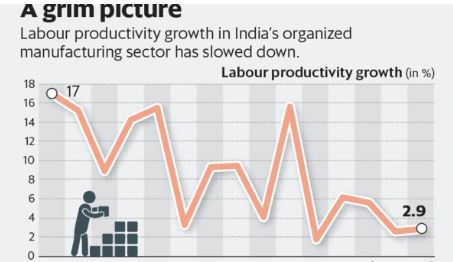Labour productivity in India’s organized manufacturing sector continues its downward spiral. India Ratings and Research’s analysis of the Annual Survey of Industries (ASI) data showed India’s productivity has fallen significantly over the last eight years (see chart).
Of course, the global economy hasn’t been in a great shape of late and is hampering manufacturing activity back home. But economists blame much of this decline on India’s complex labour laws that need urgent simplification.
“India’s labour regulations are perceived to be rigid, with multiple laws at the national level and in various states. Existing labour laws encourage a low scale of manufacturing, as many laws apply only when businesses have a certain number of workers, thus dragging productivity. As per the ASI, an overwhelming 72% of the firms in India have 0-49 employees, although the output share of such firms is just 6.9%,” UBS Securities Pvt. Ltd said in a report on 30 October.
To put things in perspective, productivity refers to how efficiently resources are used. Labour productivity is calculated by dividing the output by the amount of labour used to generate that output.
A report published by the State Bank of India Research said India’s labour productivity was significantly lower than global peers. “Even in the next decade, i.e., by 2021 it is estimated that India’s output per worker will rise to just $6,414 compared to China’s $16,698. The gap, therefore needs to be bridged through policy changes,” it said.
To improve this, the World Economic Forum suggests India must improve its product market efficiency, which is undermined by a lack of trade openness. Further, it said that India’s labour market is characterized by a lack of worker rights’ protections, insufficiently-developed active labour market policies and critically-low participation of women.
An obvious solution to India’s productivity woes will be to implement these changes. To be sure, the government is doing its bit to ease labour regulations. It plans to merge nearly 40 labour laws into four codes. One of them—the Code on Wages Bill, 2019—has been approved by the Indian Parliament.
The clamour for faster simplification of labour laws has become louder, especially after the cut in corporate tax rates. Easing labour laws coupled with lower tax rate will help boost India’s economic growth, economists said. Also, if India wants to benefit from the global supply chain disruption due to the US-China trade conflict, these measures should be adopted early on.


